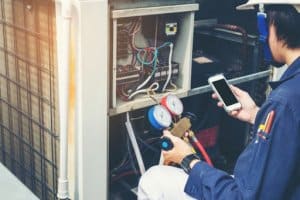As one of the leading health issues globally, indoor air pollution poses a very real environmental health concern to home and building occupants - and one that most people are completely unaware of.
But occupants don’t need to suffer in silence anymore...
Before you can improve your indoor air quality, you’ll first need to understand what is indoor air quality, and how it actually poses a threat.
Indoor air quality (IAQ) definition refers to the quality of air within a building or structure, and relates to the health and well-being of the occupants inside.
Rather than give you a definition of indoor air pollution, here are some of its many forms:
- Harmful gases, like carbon monoxide & radon
- Combustion smoke from cigarettes or a wood-burning stove
- Dust particles from toxic building materials, like asbestos
- Household cleaning supplies and air fresheners which contain volatile organic compounds (VOCs)
- Excess humidity (too much moisture in the air)
- Mold & fungi
- Absence of humidity (very dry air)
- Outside air pollutants such as smog and pesticides
Indoor air quality problems often come from multiple sources, so it’s important to stay vigilant in your surroundings.
Causes of Indoor Air Pollution
So what causes these problems?
There is no one definitive answer. It depends on a number of factors, like: the age of your building, the type of building materials used, how often you clean, what cleaning products you use, your overhead HVAC system, and even the time of year.
If you’re feeling confused or overwhelmed -- I don’t blame you.
Here are a few real-life examples to help better explain:
- You live in an older building and decide to do some interior renovations. There’s a good chance your plaster ceilings and drywall contain asbestos, and even though it’s fairly safe when untouched, breaking down the material releases highly-toxic dust and particles into the air.
- Many of us use spray bottles and scented candles, some people even install automatic air fresheners, which spray every 30 or 60 mins. What you may not know is that air fresheners are a primary source of VOCs, such as ethanol, formaldehyde and benzene. Air fresheners and cleaning products have been linked to negative health effects, including: headaches, asthma attacks, breathing problems and infant illness.
- Your condominium has an overhead HVAC system, which hasn’t undergone proper maintenance in a while. The poorly maintained system has difficulty regulating the temperature in a room - it’s either too warm or too cool, too humid or too dry - and the drastic temperature shifts can cause you to experience thermal discomfort, as well as respiratory and cardiovascular health issues. Excessive moisture can also lead to mold growth.
- You work in an older office building and you notice that every time you’re at your desk you have difficulty breathing, or perhaps your skin is constantly dry. Maybe you’ve noticed that you’re frequently getting sick.The building’s outdated ventilation system may be to blame here. Pushing air out too quickly from above, the system spreads dust, allergens and harmful pathogens into your work space, affecting your health and overall productivity at work.
Indoor Air Quality Control -- Ventilation Air Poor Indoor Air Quality
While the sources of inside air pollution often come from within the building, poor ventilation compounds the problem.
Inadequate ventilation can increase indoor pollutant levels by not bringing in enough fresh air, and by not carrying air pollutants out of the building. This is especially true for people who smoke indoors, have a lot of old carpeting or mold problems due to water damage.
Conversely, too much ventilation may also cause issues.
For example, those of you who live in big cities with smog problems can pollute your home just by leaving the windows open for some ‘fresh air.’
What are the Effects of Indoor Air Pollution?
Effects can be mild and felt immediately, depending on the source...but can also turn into serious health problems if left untreated.
Short Term
- Headaches
- Respiratory issues
- Eye & skin irritations
- Frequent cold & flu symptoms
- Dizziness and lethargy
Long Term
- Chronic breathing problems
- Heart and lung disease
- Cancer
- Possibly even death, which can happen shockingly quickly in the case of Carbon Monoxide (CO) poisoning
The Elephant in the Room: HVAC
HVAC systems provide heating & cooling effects for our homes and workplaces. Even when properly designed, HVAC does a less effective job of improving indoor air quality due to the use of older technology - but it only gets worse if the system is not adequately maintained. Here are some ways that lackadaisical maintenance can lead to air quality issues:
- Spread of dust, allergens, bacteria and other harmful substances (especially in the case of dirty or clogged air filters)
- Excessive heating or cooling can lead to discomfort and health problems
- Improper humidity
- Too much can lead to mold & fungi growth
- Too little can cause breathing problems, skin & eye irritations, etc.

Here are some clues to help recognize a faulty HVAC system:
- Air conditioned spaces that feel too humid (like a refrigerator)
- Drastic changes in air temperature
- Air being blown at excessive speeds
- Unpleasant or strange odours coming from air ducts
- Common health issues between building occupants
If you’re noticing any of the above symptoms, it’s time to have your HVAC system serviced. Failure to do so will cause it to run less efficiently, increase the chance of malfunction, and be potentially harmful to the occupants inside.
Indoor Air Quality Solutions
When thinking about how to improve the quality of your indoor environments, it’s also important to make them more energy-efficient.
Here are 3 great ways to improve indoor air quality:
- Source control and alarm maintenance. This can’t be stressed enough. If you have a gas range, make sure to get it serviced regularly. Without proper ventilation, dangerous CO will get trapped inside - and it happens more frequently than one might think. In one particular study, 51% of kitchen ranges tested raised carbon monoxide levels above the EPA standard.The same goes for your CO and smoke detectors. They’re designed to alert you at the first sign of fire, smoke, and carbon monoxide fumes. Unless these are functioning properly, it’s likely you won’t notice until it’s too late.
- Invest in a quality air purifier. Most air purifiers use filtration (mainly HEPA and carbon filters) to remove over 99% of air contaminants. The size and type needed will depend on location.A small office or apartment can get by with a portable tabletop or floor model. Larger buildings and multi-level homes are better off with a built-in purifier, which attaches to the central HVAC system.
- Consider an underfloor air distribution (UFAD) system. UFAD is an approach that’s growing in popularity due to its improved air quality, energy efficiency, and cost-effective nature - and it’s the best replacement to HVAC systems.Traditional HVAC systems work against gravity, pushing air from above and circulating pollutants for a longer period of time - directly affecting the health of occupants who breathe in this dirty air.UFAD uses air distribution ducts below the floor in order to work with gravity, pushing polluted air up and out of the occupants’ space. This technique takes 30% less fan energy to run, leaving you healthier and with more money in your pockets.
With these tips, you will not only be able to recognize poor indoor air quality, you now have the tools and knowledge to improve it.
If you’d like more information on underfloor air distribution systems, contact our team of experts at AirFixture who can help you find a solution that is right for your building.



